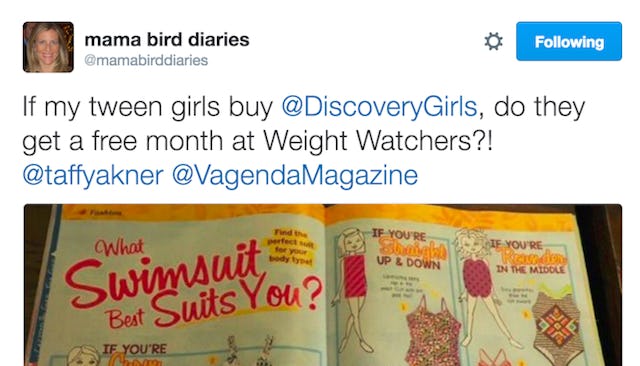Magazine Tells 8-Year-Olds How To Look Better In A Swimsuit

“Discovery Girls” is under fire for a feature telling kids how to look good in swimsuits
We’re headed into summer soon, and that means it’s time for all those obnoxious charts comparing our body shapes to different fruits, talking about the most “flattering” bikinis for hiding body fat, and berating us for not having a beach body. As grown women, we’re used to being bombarded with that garbage, but Discovery Girls magazine recently sparked outrage when they published a guide for hiding your flaws with flattering swimsuits, aimed at girls as young as eight.
The two-page spread features illustrations of different body types — “curvy up top,” “straight,” and “rounder” — along with suggested swimsuits and some mildly disturbing tips for flattering your shape. “Add curves with asymmetrical straps,” it implores scrawny elementary schoolers. “Side ties and cut-outs draw the eyes down. If you’re rounder in the middle, high-waisted bottoms work best for you.”
Um, what? Whose eyes are we drawing down exactly? Why does my nine, ten, or eleven-year-old need to add curves? And for the love of all that is holy, stop calling little girls round, you assholes.
Discovery Girls is marketed to kids ages eight to 13, and according to CBC News, boasts a readership of over 900,000. On its website, the magazine says it’s a forum to help girls “with tough issues like being rejected, not fitting in, and feeling pressured to be perfect.” That’s weird, because I’m pretty sure telling elementary schoolers how to boost up their boobies and hide their flab is absolutely pressuring them to fit into an ideal.
Since the issue went out, hundreds of people have voiced concerns, tweeting that they’re disappointed and think the chart promotes a negative self image. One pediatrician even said she’s encouraging others to remove the publication from their waiting rooms.
The criticism got so intense, the magazine’s publisher, Catherine Lee, issued a response on Facebook apologizing for the feature and writing, “It’s still hard for me to believe that an article so contrary to our magazine’s mission could have been published on our pages… The article was supposed to be about finding cute, fun swimsuits that make girls feel confident, but instead it focused on girls’ body image and had a negative impact.”
Still, as many pointed out in the comments on her response, a magazine intended for boys would never feature an article about swimsuits that help you feel confident, and it’s kind of a bullshit message either way. Women have been told since the beginning of time that if we try really hard, diet, exercise ourselves into oblivion, and choose “flattering” clothes, we can all attain one popular type of body. The pressure we feel to measure up is intense, and while I may not speak for all moms, I know so many of us want to spare our kids the feelings of inadequacy that come with failing to meet those impossible standards.
[related_post]
The messages we hear about our bodies when we’re young tend to stick. I’m a 29-year-old woman and to this day I repeat messages from my mother about how horizontal stripes make me look wide, short hair gives me a fat face, black is slimming, and heels will make my legs look less stubby. Whether these things are true or not doesn’t matter. What matters is that I learned as a young, developing girl that my body was not good enough the way it is, that I am not good enough — and decades later, those painful tapes still play in my head.
For kids reading Discovery Girls, this could very well be their first taste of a world that tells them they’re too round, too straight, not curvy or svelte in all the right places. It’s a message they’ll unfortunately hear repeated over and over again throughout their lives. It doesn’t need to start playing when they’re barely out of elementary school.
This article was originally published on